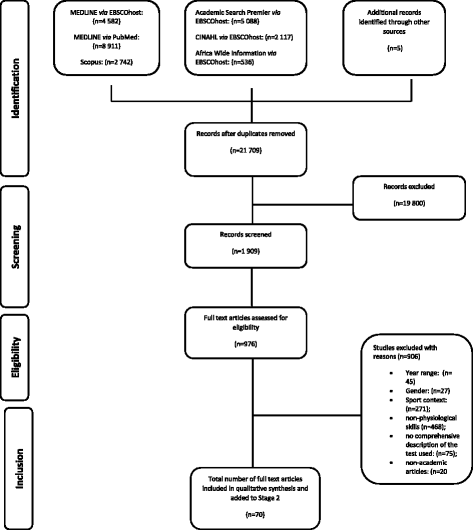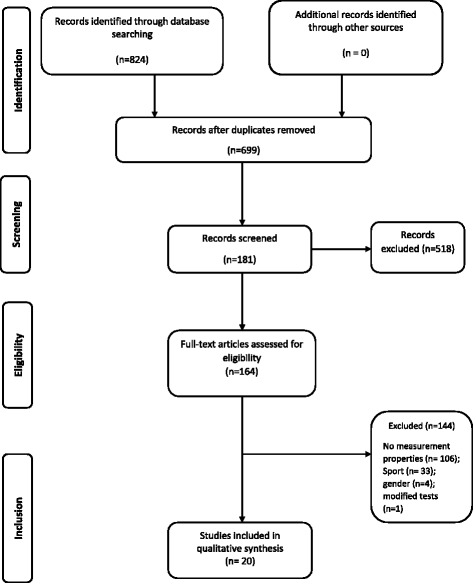A systematic review investigating measurement properties of physiological tests in rugby
- PMID: 29299317
- PMCID: PMC5745687
- DOI: 10.1186/s13102-017-0081-1
A systematic review investigating measurement properties of physiological tests in rugby
Abstract
Background: This systematic review was conducted with the first objective aimed at providing an overview of the physiological characteristics commonly evaluated in rugby and the corresponding tests used to measure each construct. Secondly, the measurement properties of all identified tests per physiological construct were evaluated with the ultimate purpose of identifying tests with strongest level of evidence per construct.
Methods: The review was conducted in two stages. In all stages, electronic databases of EBSCOhost, Medline and Scopus were searched for full-text articles. Stage 1 included studies examining physiological characteristics in rugby. Stage 2 included studies evaluating measurement properties of all tests identified in Stage 1 either in rugby or related sports such as Australian Rules football and Soccer. Two independent reviewers screened relevant articles from titles and abstracts for both stages.
Results: Seventy studies met the inclusion criteria for Stage 1. The studies described 63 tests assessing speed (8), agility/change of direction speed (7), upper-body muscular endurance (8), upper-body muscular power (6), upper-body muscular strength (5), anaerobic endurance (4), maximal aerobic power (4), lower-body muscular power (3), prolonged high-intensity intermittent running ability/endurance (5), lower-body muscular strength (5), repeated high-intensity exercise performance (3), repeated-sprint ability (2), repeated-effort ability (1), maximal aerobic speed (1) and abdominal endurance (1). Stage 2 identified 20 studies describing measurement properties of 21 different tests. Only moderate evidence was found for the reliability of the 30-15 Intermittent Fitness. There was limited evidence found for the reliability and/or validity of 5 m, 10 m, 20 m speed tests, 505 test, modified 505 test, L run test, Sergeant Jump test and bench press repetitions-to-fatigue tests. There was no information from high-quality studies on the measurement properties of all the other tests identified in stage 1.
Conclusion: A number of physiological characteristics are evaluated in rugby. Each physiological construct has multiple tests for measurement. However, there is paucity of information on measurement properties from high-quality studies for the tests. This raises questions about the usefulness and applicability of these tests in rugby and creates a need for high-quality future studies evaluating measurement properties of these physiological tests.
Trial registrations: PROSPERO CRD 42015029747.
Keywords: Physiological characteristics; Reliability; Responsiveness; Rugby; Systematic review; Validity.
Conflict of interest statement
MC is a registered second year doctoral student at the University of Cape Town. BE is the overall supervisor of the doctoral thesis. GF is a senior physiotherapy lecturer at the University of Cape Town and acting in the capacity of a co-supervisor. JD and CT are senior physiotherapists at the University of Zimbabwe. TM is a senior physiotherapist at Harare Central Hospital. EB is a physiotherapist from Ghana. SO is a recent graduate of Human Movement from the University of Maastricht in Netherlands.This study was conducted as systematic review, so no ethical approval was sought and there was no need for informed consents. However, the review forms part of a doctoral study registered under the University of Cape Town Human Research Ethics Committee (HREC 016/2016).Not applicable.The authors declare that they have no competing interests.Springer Nature remains neutral with regard to jurisdictional claims in published maps and institutional affiliations.
Figures
References
-
- Duthie GM, Pyne D, Hooper S. The applied physiology and game analysis of rugby union. Sports Med. 2003;33:937–991. - PubMed
-
- Da Cruz- Ferreira AM, Ribiero CAF. Anthropometric and physiological profile of Portuguese rugby players - part I: comparison between athletes of different position groups. Rev Bras Med Esporte. 2013;19(1):48–51.
-
- Cunniffe B, Proctor W, Baker JS, Davies B. An evaluation of the physiological demands of elite rugby union using global positioning system tracking software. J Strength Cond Res. 2009;23(4):1195–1203. - PubMed
-
- Mellalieu S, Trewartha G, Stokes K. Science and rugby union. J Sports Sci. 2008;26(8):791–794. - PubMed
-
- Argus CK, Gill ND, Keogh JWL. Characterization of the differences in strength and power between different levels of competition in rugby union athletes. J Strength Cond Res. 2012;26(10):2698–2704. - PubMed
LinkOut - more resources
Full Text Sources
Other Literature Sources
Molecular Biology Databases
Miscellaneous



